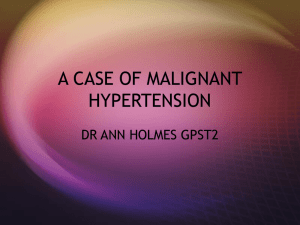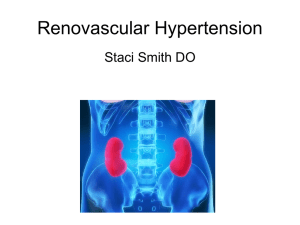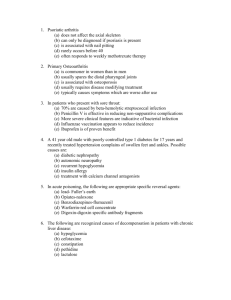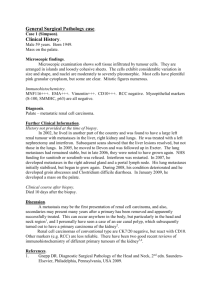MCQ Medicine
advertisement
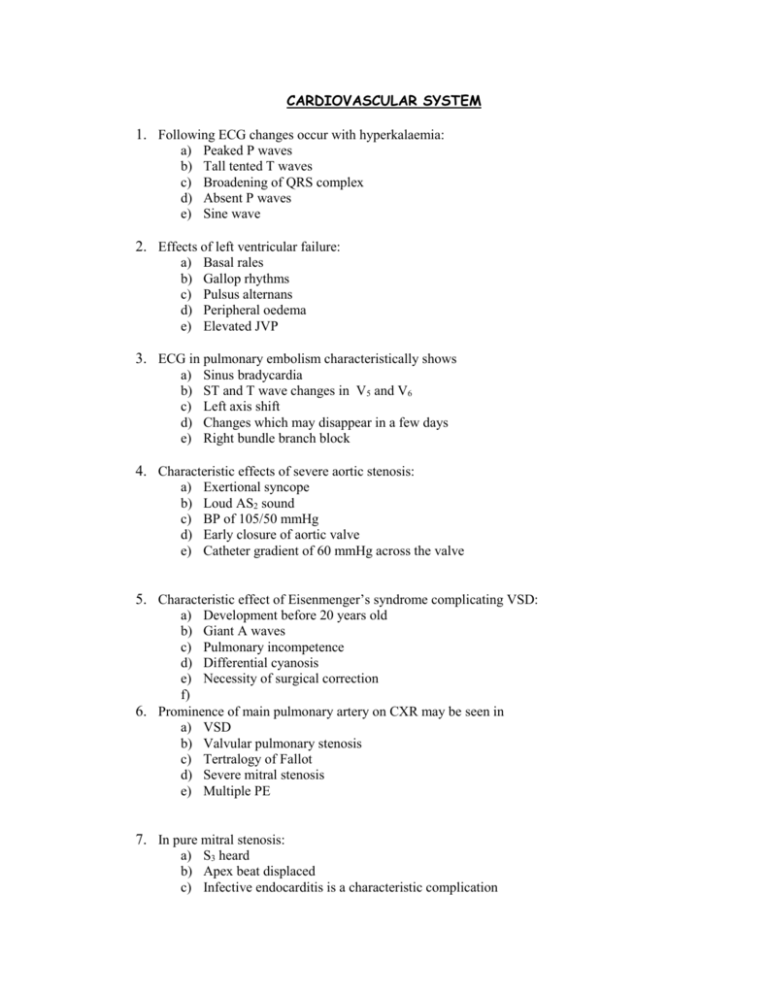
CARDIOVASCULAR SYSTEM 1. Following ECG changes occur with hyperkalaemia: a) b) c) d) e) Peaked P waves Tall tented T waves Broadening of QRS complex Absent P waves Sine wave 2. Effects of left ventricular failure: a) b) c) d) e) Basal rales Gallop rhythms Pulsus alternans Peripheral oedema Elevated JVP 3. ECG in pulmonary embolism characteristically shows a) b) c) d) e) Sinus bradycardia ST and T wave changes in V5 and V6 Left axis shift Changes which may disappear in a few days Right bundle branch block 4. Characteristic effects of severe aortic stenosis: a) b) c) d) e) Exertional syncope Loud AS2 sound BP of 105/50 mmHg Early closure of aortic valve Catheter gradient of 60 mmHg across the valve 5. Characteristic effect of Eisenmenger’s syndrome complicating VSD: a) Development before 20 years old b) Giant A waves c) Pulmonary incompetence d) Differential cyanosis e) Necessity of surgical correction f) 6. Prominence of main pulmonary artery on CXR may be seen in a) VSD b) Valvular pulmonary stenosis c) Tertralogy of Fallot d) Severe mitral stenosis e) Multiple PE 7. In pure mitral stenosis: a) S3 heard b) Apex beat displaced c) Infective endocarditis is a characteristic complication d) Females affected more than males e) Recurrent RTI is an early feature 8. In pure mitral stenosis: a) b) c) d) e) Loud S1 Prominently displaced apex Opening snap soon after the S2 suggests severe disease Graham-Steell murmur Giant V waves 9. The following statements on heart sounds are correct: a) b) c) d) e) Loud S1 in MS suggests a rigid mitral valve Splitting of S2 occurs normally during inspiration LBBB results in P2 preceding A2 A2 is normally louder than P2 S3 occurs at the termination of atrial contraction 10. 45 y.o female, non-smoker presented to A&E with chest pain for 2 hrs, no history of hypertension: a) IV analgesics are indicated b) PO aspirin is advised c) IV thrombolytic treatment is not contraindicated d) Monitoring of BP and ECG is necessary e) Patient is allowed home to return in 2 hrs for ECG 11. Characteristic features of subacute bacterial endocarditis: a) b) c) d) e) Heberden’s nodes Proteinuria Osler’s nodes Thrombocytopenia Conjunctival haemorrhages 12. During CPR, a) b) c) d) External cardiac massage must be discontinued during inflation of the lungs Intubation should be attempted immediately PE should be treated with IV adrenaline 50 mls of 8.4% sodium bicarbonate should be given as son as central line is established e) Ventricular fibrillation associated with hypotension is best treated with IV lignocaine 13. Following true about hypertension: a) Thiazide treatment is the choice in elderly b) Headache and dizziness is the side effects of mild to moderate hypertension c) There’s more of a chance finding a cause for more severe malignant than in more benign form d) Systemic hypertension often requires to treatment e) Cannot get postural hypotension in patient with previous hypertension 14. Characteristic features of aortic incompetence: a) b) c) d) e) Atrial fibrillation Heaving apex impulse Right ventricular failure BP 145/110 mmHg Diastolic murmur heard in carotid arteries 15. High risk of thromboembolism in atrial fibrillation: a) Young patient b) Cardioversion 16. Mitral stenosis and atrial fibrillation a) b) c) d) e) Past history of chorea Opening snap on auscultation Mid-diastolic murmur Presystolic accentation of murmur S4 loud 17. In myocardial infarction, a) b) c) d) Pericardial effusion rub may occur ST segment is usually evident on ECG Prolonged bed rest is essential Use of digitalis may be dangerous 18. Characters of pure mitral stenosis with atrial fibrillation: a) b) c) d) e) A loud 1st heart sound Apical pre-systolic murmur Left ventricular hypertrophy shown by ECG Increased left atrial pressure on cardiac catheterization Pulsus paradoxu 19. Subacute bacterial endocarditis can manifest itself as a) b) c) d) e) Cerebrovascular accident Anaemia Haematuria Hypertension Vasculitis 20. Clubbing can be caused by: a) b) c) d) e) COPD Cirrhosis Congenital cyanotic heart disease Bronchial carcinoma Bronchiectasis RESPIRATORY SYSTEM 1. ARDS a) b) c) d) e) May complicate incompatible blood transfusion May feature combined hypoxia and hypocapnia Simulates lobar pneumonia on CXR Is accompanied by increased PCWP Benefits from application of PEEP 2. Following investigations are indicated in a patient with BHL: a) b) c) d) e) Mantoux test Kveim test Serum Ca2+ CT scan Lung biopsy 3. Cystic fibrosis a) Results from mutation in CFTR b) Characterized by decrease in transepithelial electrical potential difference c) Shows significant clinical response to N-acetyl-cysteine d) Causes death principally from GI complications e) Is managed with aerosolized tobramycin to delay pulmonary exacerbations f) 4. With bronchiectasis, a) Haemoptysis common b) Clubbing common c) CXR commonly confirms diagnosis d) Coarse crepitations overwhelmed e) Sympathetic eventually recessing 5. Sister (24 y.o) of a boy diagnosed with CF a) b) c) d) Does not have CF because she is asymptomatic Has 50% chance of being a carrier Her children have ¼ chance of getting CF A genetic test exists for diagnosis of CF 6. Hereditary conditions: a) b) c) d) e) Cystic fibrosis Bronchial carcinoma Tuberculosis Kartagener’s syndrome Atopic asthma 7. In pneumonia consolidation, following statements are correct: a) b) c) d) e) Percussion note is characteristically stony dull Breath sounds are bronchial Kerly’s lines are seen in CXR during resolution Sputum contains Curshmann’s spirals Cavitation suggests a staphylococcal aetiology 8. Surgery is indicated in bronchial carcinoma if: a) b) c) d) e) Oat cell carcinoma Lymph node in left supraclavicular Clubbing Recurrent haemoptysis Hoarseness for 3 wks 9. Asthma is favoured against bronchial carcinoma if: a) Symptoms mainly at night b) History of asbestos exposure c) Tracheal deviation to the left 10. In TB: a) 4 mths of rifampicin, isoniazid, pyrazinamide + 2 mths rifampicin, isoniazid b) Some of these drugs affect levels of COCP 11. In relation to sarcoidosis, the following are true: a) b) c) d) e) It is a disease characterized by caseating granulomatous inflammation It is the commonest cause of bilateral hilar lymphadenopathy in Ireland Hypercalcaemia of sarcoidosis may be exacerbated by sun exposure Steroids are indicated for athralgia in patients with sarcoidosis Inhaled steroids may be useful in patients with pulmonary sarcoidosis 12. The following features are consistent with a diagnosis of Horner’s syndrome in a patient with Pancoast tumour: a) Ipsilateral ptosis b) Increased sweating on the affected side c) Exophthalmos d) Tongue deviation to the contralateral side e) Ipsilateral miosis 13. In patient with pleural effusion: a) b) c) d) e) Bronchial breathing may be heard above the effusion A protein content of 40g/L suggests heart failure may be the cause Pleural effusion may occur in the patient with an ovarian tumour Atypical pneumonia is a classical cause of a pleural effusion Acute pancreatitis may cause a left-sided pleural effusion and ascites may cause a right sided effusion 14. Bronchial carcinoma is a recognized occupational hazard in the following industries: a) b) c) d) e) Coal mining Manufacture of coal gas Asbestos industry Welding Manufacture of aniline dyes 15. Young male caretaker in a boarding school presents with prodromal illness followed by cough and dyspnoea. CXR – shadows in the right lower lobe. The following is appropriate: a) FBC and ESR b) Mycoplasma antibodies c) Cold agglutinins 16. Features of Brucellosis includes: a) Phylectenular conjunctivitis b) Allergic alveolitis c) Lymphadenopathy 17. An open ward demonstrated tubercle bacillus on several sputum samples. The following should be done: a) Transfer patient to a single room b) Incinerate all his personal clothes c) Tell his family that it is unlikely that they are infected d) Arrange skin tests and CXR for family contacts e) Commence drug therapy before TB culture results are available GASTROENTEROLOGY 1. A 41 y.o female presenting with DM, pigmentation and hepatomegaly. The following supports diagnosis of idiopathic HH: a) History of heavy smoking b) Serum K+ 6.2 mmol/L, serum Na+ 119 mmol/L c) Arthropathy of spine d) Cardiac enlargement e) Thrombocytosis f) Cardiac arrhythmias g) Impotence h) Hypertension 2. Following statements is about chronic alcoholism: a) Commoner in males than females b) Hallucinations during DT – characteristically of visual kind c) After having abstinent for 1 year 50% able to resume social drinking under supervision d) It may be associated with other psychiatric illness e.g. depression e) Prognosis is worse in males than in females 3. Alcoholic presenting with hepatosplenomegaly and haematemesis: a) b) c) d) e) Bleeding can be assumed to oesophageal varices Vitamin K will reverse all clotting defects Presence of blood in GIT may be harmful Lactulose, magnesium sulfate and neomycin will all be helpful Features of encephalopathy including fetor and altered consciousness 4. In patient with chronic liver disease, a) b) c) d) e) Increased serum Na+ is typical Incidence of hepatoma is low Treatment with a porto-caval shunt increases likelihood of encephalopathy GI bleeding may precipitate encephalopathy There is an increased clotting tendency 5. Portal systemic encephalopathy with advanced liver disease may be precipitated by a) b) c) d) e) Eating 200 gm lean chicken IV glucose High-dose loop diuretics Standard dose morphine sulphate Oral lactulose 6. The following are associated with hereditary haemachromatosis: a) b) c) d) e) Glycosuria Infertility Pulmonary emboli High dietary intake of iron Hepatocellular carcinoma 7. In hepatic disease: a) Jaundice is usually present in patients with acute hepatitis b) Splenic atrophy is associated with portal hypertension c) Non-alcoholic steatohepatitis (NASH) responds to steroid therapy 8. Associations: a) b) c) d) Ulcerative colitis --- dermatitis herpetiformis MS --- erythema nodosum Primary biliary cirrhosis --- hyperlipidaemia Celiac disease --- osteomalacia 9. Extra-intestinal manifestation of IBD include: a) b) c) d) e) Sacroilitis Erythema nodosum Syndenham’s chorea Pyoderma gangrenosum Neuropathy 10. In ulcerative colitis: a) b) c) d) e) Men and women are equally affected Rectum is generally spared Presence of pyoderma gangrenosum relates to disease activity Increase incidence of both LB and biliary carcinoma Elemental diets have significant therapeutic benefit in acute relapse 11. Recognized complication of ulcerative colitis: a) b) c) d) e) f) g) h) i) Aphthous ulceration Erythema marginatum Pyoderma gangrenosum Large bowel lymphoma Cirrhosis Carcinoma of colon Arthritis Thyroiditis Pleural effusion 12. Crohn’s disease, as compared to ulcerative colitis, is characterised by: a) b) c) d) Perianal abscess Fistula Granulomata Rectum affected 13. Abdominal pain may be caused by: a) b) c) d) e) MI Mesenteric infarction Porphyria Pneumonia Ureteric calculi 14. Jaundiced patient has urobilinogen but no bile in urine, may have: a) b) c) d) e) Congenital spherocytosis Carcinoma of head of pancreas Haemachromatosis Massive pulmonary embolus Ascending cholangitis 15. Clinical features of acute hepatitis: a) b) c) d) e) Dislike of cigarettes Splenomegaly Glycosuria Anorexia Bilirubinuria 16. In hereditary haemachromatosis: a) b) c) d) e) Inheritance is autosomal dominant Chondrocalcinosis is a recognized feature Bronze skin pigmentation due to iron deposition Cardiac failure may be a presenting feature Hepatoma is an important complication RENAL MEDICINE 1. In patient with renal impairment and increased urea and creatinine: a) IV urogram is the best method of visualizing b) Urinary output is a reliable method of differentiating between acute and chronic renal failure c) Haematuria and proteinuria indicate glomerular disease d) Polycystic kidneys are usually associated with liver disease 2. About renal transplantation: a) CMV is treated with ganciclovir b) ADPKD recurs in the graft c) Azathioprine levels need to be monitored on regular basis 3. Polycystic kidney a) b) c) d) Is transmitted as autosomal dominant Often presents in childhood Causes hypertension Is associated with cystic liver disease 4. Renal artery stenosis a) Is found in up to 50% of patients undergoing peripheral angiopraphy b) Should be suspected if there is more than 0.5cm difference in kidney size on ultrasound c) Typically presents with ‘flash’ pulmonary oedema when unilateral d) Is associated with hypokalaemia e) Nearly always progress to complete occlusion 5. Haematuria: a) b) c) d) e) f) g) h) i) Acute pyelonephritis Post-streptococcal glomerulonephritis Obstructive nephropathy Polycystic kidney disease Goodpasture’s syndrome Nephropathy associated with diabetes mellitus Infective endocarditis Acute papillary necrosis Steroid sensitive 6. Advanced renal failure is associated with: a) b) c) d) Repeated paracetamol abuse Hypersplenism Hyperkalaemia Pleural effusions 7. Nephrotic syndrome is a well recognized feature of: a) b) c) d) e) Chronic pyelonephritis Renal papillary necrosis Thrombosis of renal vein Proliferative glomerulonephritis Disseminated lupus erythematosus 8. Excretion urography (IVP) can be diagnostic in: a) b) c) d) e) Chronic pyelonephritis Acute glomerulonephritis Renal artery stenosis Polycystic kidney Nephrotic syndrome 9. A young male presenting with rigors, dysuria and a 103° pyrexia. What will you do? a) b) c) d) MSU, differential WBC, blood culture IVP before starting treatment Do not treat with antibiotic before getting culture back Oral penicillin is the choice of treatment 10. A 75 y.o male with gross painless haematuria: a) b) c) d) e) Should have a rectal examination May be TB Should be reassured if IVP is normal Should be given Vitamin B Is likely to have renal stenosis ENDOCRINOLOGY 1. In relation to patients with Type 2 NIDDM: a) Control of body weight improves glycaemic control b) Hypertension is more prevalent than in non-diabetic population c) The earliest indicator of nephropathy is the presence of proteinuria on dipstick urinalysis d) Early introduction of ACE-inhibitor therapy may reverse renal disease in patient with nephropathy e) Insulin therapy may be required during an intercurrent illness 2. Regarding endocrine disorders: a) Glucocorticoid therapy in Addison’s disease is a recognized cause of osteoporosis b) Galactorrhoea in hyperprolactinaemia c) Hashimoto’s thyroiditis is usually associated with exophthalmos d) Conn’s syndrome is associated with DM 3. A 41 y.o male with poorly controlled IDDM Type 1 for about 17 years recently treated with hypertension complains of swollen feet and ankles. Possible causes are: a) Diabetic nephropathy b) Autonomic neuropathy c) Recurrent hypoglycaemia d) Insulin allergy e) Treatment with CCB 4. The following may be of value in the treatment of hirsutism a) Regular waxing b) Spironolactone c) Low-dose dexamethasone at night 5. Diagnosis of insulinoma is suggested by: a) b) c) d) e) Fasting hypoglycaemia Hypoglycaemia relieved by meals Hypoglycaemia coming on 1-2 hours after meals Hepatic disease in an alcoholic Hypoglycaemia with a very low plasma insulin 6. Complication of DM: a) b) c) d) e) Selective loss of pain and temperature sense in lower limb Azoospermia in males Postural hypotension Fungal infections Aseptic necrosis of femoral head 7. About insulin: a) b) c) d) e) Synthesized in the pancreas in delta cells Promotes fat synthesis Moves K+ into cells Can cause temporary error of fraction May cause fat infiltration of liver 8. Administration of the following hormones may induce hyperglycaemia: a) b) c) d) Diazoxide Noradrenaline Thyroxine Glucagon 9. Statements: a) b) c) d) e) Connective tissue disease is commonest in middle-aged women Pretibial myxoedema is seen in thyrotoxicosis Cushing’s syndrome in female usually give rise to amenorrhoea Acromegaly may give rise to hypertension Calcified ascending aorta on CXR suggests syphilis 10. Premature menopause is suggested by a) b) c) d) Progesterone withdrawal bleeding Increased serum prolactin History of AIDs ??? Increased FSH levels 11. Consequences of irradiation to the neck: a) b) c) d) e) Hypothyroidism Hyperthyroidism Thyroid cancer TSH deficiency Jugular vein phlebitis 12. Acromegaly is associated with: a) b) c) d) e) Galactorrhoea Connective tissue diseases Insulin hypersensitivity Homonymous hemianopia Deep furrows of brows NEUROLOGY 1. Motor neurone disease a) Is a progressive, neurodegenerative disease involving mainly the spinothalamic tracts b) Is predominantly a disease affecting the females c) Repiratory muscles involvement is unusual d) Is typically associated with progressive cognitive impairment e) Prognosis is usually in the order of 3-5 year survival 2. Dementia: a) b) c) d) Most common cause is vascular Short term memory usually remain intact Cholinesterase inhibitors can/ should not be given in severe cases Sudden deterioration of cognitive function 3. Parkinson’s: a) b) c) d) Alt (alternating/alternative???) defects in dopaminergic transmission Tardive dyskinesia is typical Cogwheel rigidity is a feature Pill-rolling tremor is characteristic 4. Immediately following an ischaemic stroke: a) b) c) d) e) Hypertension should always be aggressively treated Patient may have a flaccid paralysis ECG should always be performed An absent gag reflex is an indication for PEG insertion Patient with atrial fibrillation should always be on anticoagulant 5. The following associations are correct: a) b) c) d) e) Fracture of middle cranial fossa --- Battle’s sign Fracture of anterior cranial fossa --- raccoon eyes Extradural haematoma --- middle meningeal arterial haemorrhage Subarachnoid haemorrhage --- meningism Subdural haematoma --- hydrocephalus 6. On waking, a 34 y.o female complains of diplopia. She was found to have external deviation of the left eye with dilated pupil on the same side. You would: a) Be surprised to find ipsilateral ptosis of the eyelid b) Be surprised if the left pupil constricted when the light shone on the left eye c) Include DM in the differential diagnosis d) Exclude infection from differential diagnosis e) Be surprised to hear a bruit on listening with the stethoscope placed over the left eye RHEUMATOLOGY 1. A patient presents with a tender swollen knee: a) An x-ray of the joint is likely to be abnormal if aseptic arthritis is present b) The finding of bony swelling at the distal interphalangeal joints is suggestive of osteoarthritis c) A diagnosis of gout is made only if serum uric acid is elevated d) A previous history of dysentery and the presence of conjunctivitis are suggestive of Reiter’s syndrome e) A diagnosis of SLE requires the presence of anti double-stranded DNA antibodies 2. Ankylosing spondylitis: a) b) c) d) e) Occurs more commonly in females more than 40 y.o Is significantly associated with the presence of HLA-B27 antigen May present with sciatica May be complicated with arthropathy affecting the hips May be complicated by iritis 3. In rheumatoid arthritis: a) b) c) d) ESR is a good index for disease activity Renal lesions commonly occur Nodules may occur over bony prominences Osteoporosis is a common radiological finding adjacent to affected joint 4. Sacroiliac involvement is commonly found in the arthropathy of: a) b) c) d) e) Ankylosing spondylitis Reiter’s syndrome Gout Rheumatoid arthritis Ulcerative colitis 5. Rheumatoid arthritis: a) b) c) d) Typically worst in the mornings Hoarseness Reduced breath sounds at the base Nodules on the flexor aspect of arms INFECTIOUS DISEASE 1. In a patient with a suspected diagnosis of HIV infection: a) Antibody tests are diagnostic in the seroconversion phase b) Absence of a history of IV drug abuse, blood transfusion, homosexuality and haemophilia makes a diagnosis of HIV highly unlikely c) HIV RNA levels are more predictive of prognosis than CD4 counts d) Pneumocystis carinii pneumonia is more likely when a CD4 count is less than 200/mm3 e) Anti-retroviral therapy is reserved for late stage disease to avoid the development of drug resistance 2. Infectious mononucleosis: a) b) c) d) Spontaneous splenic rupture may occur Severe exudative pharyngitis is a recognized feature There is a 6 months incubation period Rose spots on the abdomen are diagnostic 3. In patients who present with sore throat: a) b) c) d) e) 70% caused by β-haemolytic strepcoccal infection Penicillin V is effective in reducing non-suppurative complications More severe clinical features are indicative of bacterial infection Influenza vaccination appears to reduce incidence Ibuprofen is of proven benefit 4. Measles: a) b) c) d) e) f) No longer infected after the rash has faded Can cause severe pneumonia in adults Causes a rash which typically starts behing the ears and on the forehead Causes minute patches of necrosis on the buccal mucosa Can be followed by a subacute sclerosing panencephalitis after apparent recovery Is characterized by suboccipital lymph nodes 5. Parasites are found in bucca (cheek) of patients suffering fr a) Lyme disease b) Schistosoma japonicum c) Trypansomiasis cruzi (Chaga’s disease) DERMATOLOGY 1. A female presented with a facial rash for 4 weeks: a) b) c) d) e) A history compatible with rosacea Psoriasis could be a cause Trial of oral steroids is advised H2-antagonist could be a cause Photosensitivity rash is a possible cause 2. Psoriasis: a) b) c) d) e) Scalp rarely affected There is hereditary predisposition Rash usually dry and scaly Rash always aggravated by sunlight Pitting nails can be seen 3. Statements: a) b) c) d) e) Warts are caused by virus Plantar warts (verrucae) should be treated by radiotherapy Impetigo is not contagious Hodgkin’s disease can cause pruritus Scabies is not contagious 4. Characteristic lesions of psoriasis include: a) b) c) d) e) Pitting of nails Ulcerating lesions in skin flexures Avoidance of direct sunlight may improve lesions Arthropathy which spares the spine Associated with HLA-B87 5. In adult, following are recognized cutaneous manifestations of internal malignant neoplasia or reticulosis: a) Dermatomyositis b) Acquired ichthyosis c) Acanthosis nigrans d) Lichen planus e) Herpes zoster HAEMATOLOGY 1. A 25 y.o male presented with sore throat for 4-5 days. On examination, his temperature was 38°C, his tonsils were enlarged and inflamed, and bilateral axillary, supraclavicular and inguinal lymph nodes tenderness. a) Chronic myeloid leukaemia b) Infectious mononucleosis c) Acute toxoplasmosis d) Chicken pox e) HIV infection 2. Groin lymphadenopathy may occur with: a) b) c) d) e) Cancer of the anus Uterine and cervical cancer Testicular neoplasm Cellulitis of the lower limb Lymphoma 3. Anaemia of chronic disease is associated with: a) b) c) d) e) Low ESR Decreased serum iron Decreased utilization of iron No response to oral iron Decreased serum transferring 4. Haemolytic anaemia: a) b) c) d) e) Excess urobilinogen is present in urine Itching is a feature Coomb’s test may be positive Red cell fragility may be increased Faeces pale 5. Haemolytic anaemia is a feature of: a) b) c) d) e) Malaria Tropical sprue Hookworm disease Thalassaemia Brucellosis BIOCHEMISTRY 1. Hypercalcaemia of malignancy: a) b) c) d) e) May present with confusion and impaired cognition Often confused with opioid overdose Indicator of poorer prognosis Should be managed with fluid restriction Associated with myeloma 2. Hypokalaemia may be associated with: a) b) c) d) e) Administration of insulin Conn’s syndrome Addison’s disease Diarrhoea Terminal stages of chronic renal failure DRUGS 1. Side effects: a) b) c) d) Fine crackles at lung bases --- methotrexate Ataxia --- anticonvulsants Myalgia --- statins Tinnitus --- paracetamol 2. Verapamil: a) b) c) d) e) Inhibit Na/K ATP-ase Causes hyperkalaemia May be used to treat ventricular tachycardia at an arrest Is a negative inotrope Should be given IV quickly for maximum therapeutic effect 3. Drugs and common indications for their use: a) b) c) d) e) ACE-inhibitor and left ventricular failure β-blockers and asthma N-acetylcysteine and tricyclic antidepressant overdose Verapamil and ventricular tachycardia Bisphosphonates and hypercalcaemia of malignancy 4. Ototoxicity is an important adverse effect of a) b) c) d) e) Salicylates Nitrofurantoin Aminoglycoside Furosemide Atropine Contraindication to β-blockers: f) Raynaud’s phenomenon g) Atrial fibrillation in thyrotoxicosis h) Wolff-Parkinson-White syndrome i) Asthma j) Parkinson’s disease 5. Overdose: a) Invariably involves alcohol as well b) Opiates --- pin-point pupils c) Naloxone --- reverse opiates 6. High dose steroid treatment causes a) b) c) d) e) PUO Osteoporosis Adrenal adenoma Adrenal suppression Peptic ulceration 7. Propanolol causes a) b) c) d) e) Increased cardiac output Hypotension Bronchodilation Abolishes arrhythmia induced by digitalis Tachycardia
